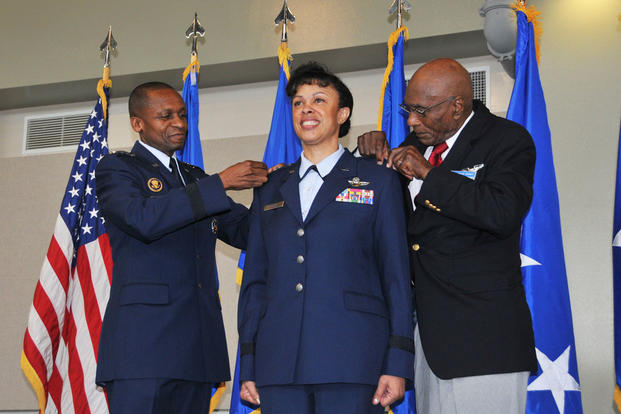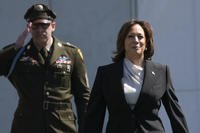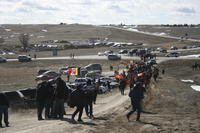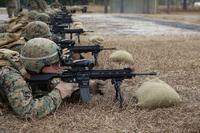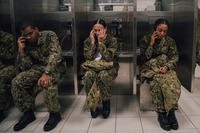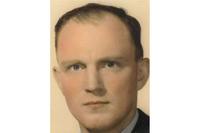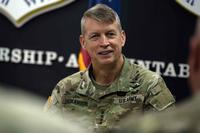It has been a big year for women in the military, as 2016 marked the first time women could apply to serve in all military occupations and positions and saw more female leaders hit occupational milestones.
Lt. Gen. Stayce Harris, a reserve pilot by trade, this year became the first female African-American to ever achieve the rank of lieutenant general for the Air Force, and earned the job of assistant vice chief of staff and director of the air staff for the service. She is also the first woman and the first reservist to return to active-duty to fill the position.
But these achievements don't dictate how Harris views herself or her career. She said she simply wants to light a spark for others to realize they too can serve their country.
"I think my passion has always been, and I realize that about myself, my passion, although I can think strategically, I really am a grassroots leader and I care deeply about the airmen," Harris recently told Military.com in an interview. "So the smallest things that airmen have angst about, I feel. So even though we have evolved in technology...sometimes there isn't the greatest interoperability with the Guard and Reserve, and I would like to help those issues."
Harris is the mediator between the air staff, the Air Force secretary's staff and the major commands, plus the staff directors from the other services. Additionally, she will engage with civic leaders, and acts as the certifying official for air attaches.
"Initially I just want us to be more organized. But I want us to collaborate more," Harris said.
"I think in a lot of organizations, especially ones that have been in place for a long time, you operate in silos. There's great work going on in those silos, but a lot of work is duplicated amongst other silos, and what I want to do is to really rally the team to see where we no longer have to duplicate efforts but compliment each other's efforts."
Harris' beliefs mimic Chief of Staff Gen. David Goldfein's push to review and revitalize the makeup of "the fundamental unit" of squadrons, which he announced in greater detail last month at the annual Air Force Association's Air, Space & Cyber Conference.
"He means it when he says one Air Force, three components, that we should be able to seamlessly integrate to serve in these roles," Harris said, adding she was most looking forward to executing Goldfein's vision. "I feel his passion. If you can help an airman at the grassroots level, the mission will always be accomplished."
Service in the Family
Following in the footsteps of her father who was in the Air Force, all Harris knew was that every two years the family got "to move to a new and exciting place." She enrolled in junior ROTC in high school, and quickly got involved in leadership labs and drill teams. She went on to study engineering at North Carolina State University, later transferring to University of Southern California.
Harris pursued the undergraduate pilot training program while in school. In 1976, women entered pilot training as military personnel for the first time, a milestone that signified women could fly outside of the Women's Auxiliary Ferrying Squadron or the Women's Airforce Service Pilots, which were both disbanded around the same time. In 1977, ten women became members of the Air Force's first group of female undergraduate pilot students. But because of poor eyesight, Harris graduated and initially went on active-duty in 1982 as a civil engineer at Hill Air Force Base, Utah.
"I did eye exercises, I ate carrots...I took the physical, my eyes passed and I reapplied for pilot training all over again," Harris said. She was formally accepted, and began training in 1983.
She first flew C-141 Starlifters at Norton Air Force Base, California; in 1990 she left active-duty to become a reservist and also commercially fly for United Airlines. Moving between assignments -- from California to Washington, D.C. -- Harris landed her first command post in 2001 as the commander of 729th Airlift Squadron at March Air Reserve Base, California.
"I commanded there for a year, during 9/11, and had an incredible team of airmen that led and flew superbly, especially during that time when no other planes were flying, your Air Force planes were flying, and we were actually delivering firemen and their supplies from California to New York City at that time," she said.
Harris eventually transitioned to the KC-135 Stratotanker, and deployed to Moron Air Base, Spain in 2003 -- the base at the time acted as a staging point for U.S. forces headed to Iraq and as "the tanker bridge" for aircraft headed to the Middle East; She served as a wing commander once more at Andrews Air Force Base, Maryland, before thrice becoming a mobilization assistant to the commander at U.S. Africa Command, the 18th Air Force at Scott Air Force Base, Illinois, and then Air Mobility Command, also at Scott.
While serving under AFRICOM, she oversaw projects such as pandemic disaster response, and would TDY for weeks at a time to various countries across Africa.
"Basically, I became the face for AFRICOM for [this] response, and what's really interesting when you're in countries for this, you bring civilians and the military together to ensure you save the lives of the populous," Harris said. It was the only forum of its kind, Harris said, that allowed for women and children of African countries to constructively speak with their militaries and the U.S. about preserving the lives of their family. Two years after Harris left her post, the West Africa Ebola outbreak struck countries like Guinea and Liberia.
"I was watching the nations that had the greatest challenges or those that were able to just stomp it right out, and the nations we assisted in these programs did very well, and I think it's because they had a cohesive plan that integrated the military and civilian communities in order to save lives."
She was last the commander of the Air Force Reserve's 22nd Air Force at Dobbins Air Reserve Base, Georgia, leading more than 15,000 airmen, 105 unit-equipped aircraft and worldwide operational missions to include the specialized hurricane hunter, fire suppression and aerial spray missions. "Largest mission set is the C-130, so I had the Hs and Js," she said.
On Aug. 19, she returned to active duty for the vice chief role.
"The nice thing is no one's talking about" my firsts, Harris said. "I hardly will ever talk about 'first' in a role because for me, I view success as seeing other people who look like me around the table. If I'm the person who facilitates making that easier for others to follow on the path, then it's all good," Harris said.
"So for me, I've got to do a great job that paves the way for others to follow."
-- Oriana Pawlyk can be reached at oriana.pawlyk@military.com. Follow her on Twitter at @Oriana0214.
Related Video:
Two Minute Brief: Women in the U.S. Military
